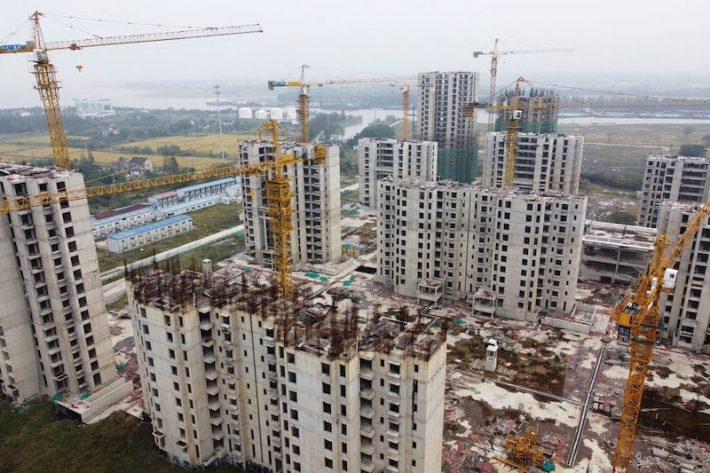The fiscal package set to be debated by China next week will seek to ease local governments’ debt woes and bolster the property sector, rather than try to generate a prompt boost to consumption, analysts say.
It aims to stabilize the country’s economy and bolster the property sector, which is weighing down the economy and fuelling deflation, they said.
Larger-than-expected monetary stimulus last month fuelled unfettered investor speculation about a complementing, blockbuster fiscal programme to immediately revive sagging economic activity.
ALSO SEE: China Hackers Targeted Trump Family, Biden Aides, NYT Reports
On Tuesday, Reuters reported that China’s top legislators will next week consider approving new debt issuance of more than 10 trillion yuan ($1.4 trillion) in coming years.
Hidden debt, buybacks of idle land, flats
Some 6 trillion yuan will go chiefly towards lowering the off-the-books debt of municipalities, while 4 trillion will fund buybacks of idle land from cash-strapped developers and help reduce a giant inventory of unsold flats.
The measures in the works represent a more calibrated approach to stimulus, which is a departure from previous all-out strategies to revive growth.
In 2008, for example, China threw lavish resources directly at the infrastructure and property sectors to counter the effects of the global financial crisis.
“The primary goal of this stimulus is clearly more about shoring up balance sheets rather than boosting near-term GDP growth,” Christopher Beddor, deputy China research director at Gavekal Dragonomics, said.
“It should ease the strains, but not necessarily generate instantly higher spending.”
‘Excesses of previous stimulus’
This prudent approach is partly informed by the fact that China is now suffering from the excesses of previous stimulus. But it also leaves open questions about the impact the measures will have on short- and long-term growth.
That lingering uncertainty is reflected in financial markets, with Chinese stocks down about 0.5% on Wednesday, pulling other Asian markets lower.
“The package can be a painkiller, rather than a booster for the economy,” Gary Ng, senior economist at Natixis, said. “The economic impact may not be as big as it looks on the surface.”
Still, a programme worth more than 8% of the world’s second-largest economy’s gross domestic product (GDP) cannot be dismissed.
“It’s not just about quantity. It’s about providing a sense of stability,” Zong Liang, chief researcher at state-owned Bank of China, said.
Local governments, facing high debt and falling revenues, have been cutting civil servants’ pay and other expenses. Property developers starved for cash have struggled to resume work on incomplete projects, hitting jobs and incomes.
China hopes to unclog the pipes that transmit money to businesses and consumers by shifting liabilities onto the central government’s healthier balance sheet, which only carries a debt load of 24% of GDP.
Liquidity squeeze
“Policymakers seem to sense that there’s a major liquidity squeeze right now unfolding among local governments, in large part due to the property downturn, leading many local authorities to stop paying their staff and corporate suppliers,” Gavekal’s Beddor said.
Tackling that squeeze releases resources into the real economy, but the impact may only show up in the second half of 2025, he added.
Another lingering question is whether the package merely postpones the debt crunch.
The International Monetary Fund calculates explicit local government debt at 31% of GDP at the end of 2023, that of their finance vehicles at a further 48% of GDP, and other government-related debt at another 13%.
Add the central government’s debt and the total reaches 116 trillion yuan, the Fund estimates.
In the property sector, Goldman Sachs estimates the unsold real estate inventory, if fully built, would amount to 93 trillion yuan ($13 trillion).
Overcoming these past excesses hinges on whether the package can kick off a virtuous growth circle that allows China to curb, rather than simply transfer these liabilities.
‘Limited growth impact’
Many analysts say a decades-old household consumption deficit holds back such prospects.
Low wages, high youth unemployment and a feeble social safety net leave China’s household spending below 40% of GDP, or about 20 percentage points behind the global average.
While Beijing is also expected to unveil consumer subsidies for appliances and other goods, the amount will be a tiny fraction of the gap.
“It seems support for consumption remains modest,” Louis Kuijs, chief Asia economist at S&P Global, said.
“That means it remains unlikely that we will see a substantial improvement of the economic growth outlook or that deflation risks have been vanquished.”
- Reuters with additional editing by Jim Pollard
ALSO SEE:
China ‘May Issue $1.4 Trillion in Extra Debt Over a Few Years’
Foreign Firms Scale Down Plans as China’s Economy Weakens
Trump Says He’ll Hit China With Big Tariffs if it Takes Taiwan
Top Chinese Lawmakers to Meet in Week of US Election
China Reduces Key Lending Rates in Bid to Rev up Economy
China Ramps up Spending on Housing Projects to $562bn
China Asks Banks to Roll Over $13tn Local Debt at Lower Rates
China’s Top Cities Set to Lift All Curbs on Homebuyers
China’s Third Quarter Growth is Weakest Since Early 2023
























